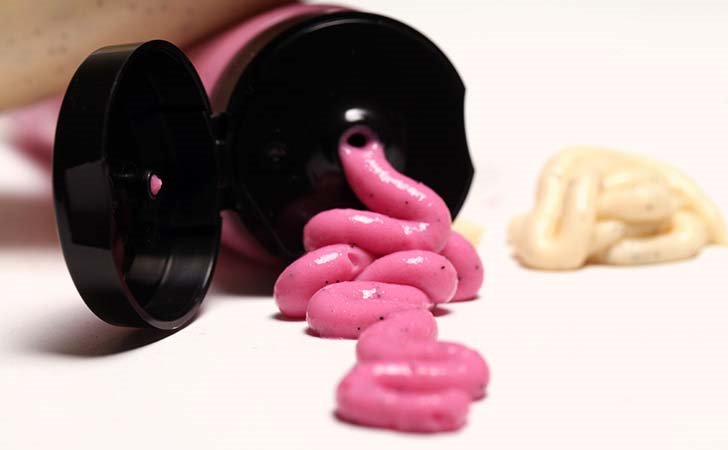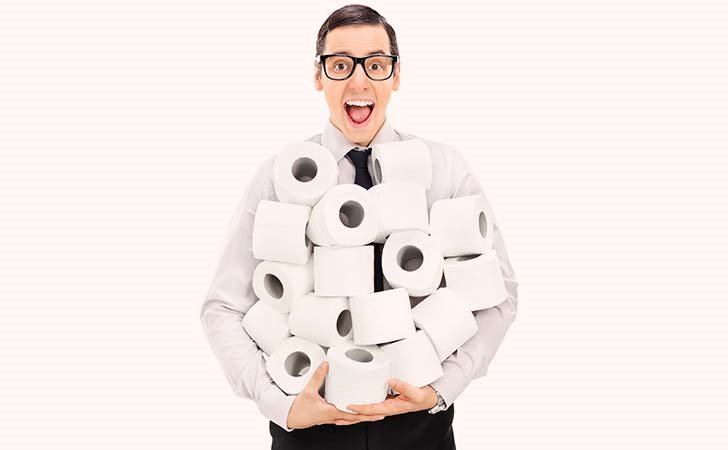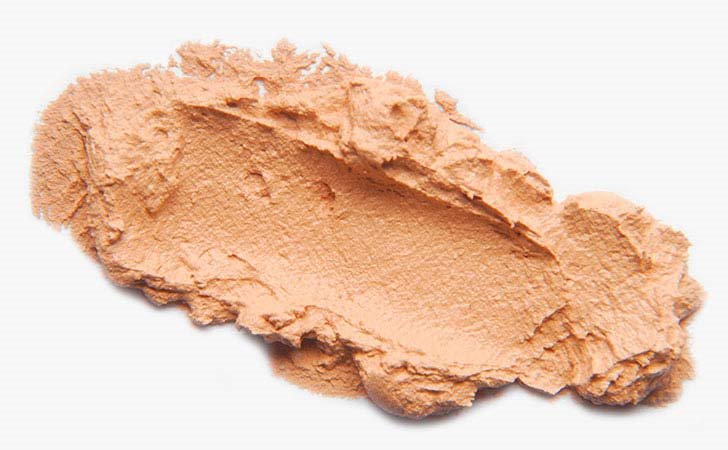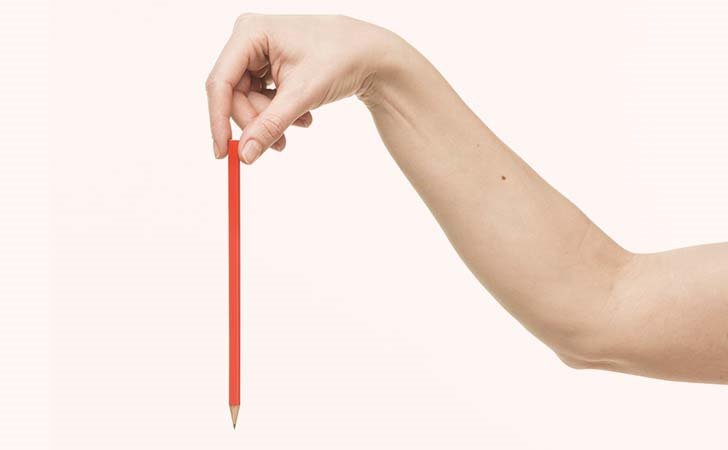
Most of us just flush and forget. But there’s reason to pay attention to what’s in your toilet bowl.
Bowel movements can reveal whether we’re eating right, staying hydrated and maintaining our systems. And it can clue us into health issues.
“Daily attention can tell you whether you eat enough fiber or have health problems, like cancer or inflammatory bowel disease,” says Anish A. Sheth, MD, a gastroenterologist at University Medical Center of Princeton in New Jersey and co-author of What’s Your Poo Telling You? (Chronicle Books).
So what are you looking for when you go No. 2? Changes in appearance, color and smell, Dr. Sheth says.
You have plenty of chances to spot any issues because it’s normal to go anywhere from three times a day to three times a week.

1. Pebbly poop
What it means: You’re probably not getting enough fiber in your diet, so your bowel movements aren’t clumping in larger lumps.
“The recommended amount of fiber is 25-35 grams a day,” Dr. Sheth says. “That will take care of pebble poo.”
Consuming that much fiber is easier than you think:
- A cup of raspberries = 8 grams
- A half-cup of lentils = 8 grams
- A half-cup of cooked greens = 4 grams
- A cup of whole-wheat pasta = 6 grams
Hydrate: Small poo clumps could also mean you’re not drinking enough fluids, says Mariam Fayek, MD, a gastroenterologist at the Center for Women’s Gastrointestinal Services, Women and Infants Hospital in Providence, RI.
“Women have long colons, so the waste has a longer transit time,” she explains. “And the longer it’s in the colon, the harder [and drier] it gets.”
Drink at least six 8-ounce glasses of water a day if you suspect that’s the issue, she advises.
When to worry: By itself, pebbly poo isn’t worrisome, Dr. Sheth says.
But if you also feel that you’re not emptying your bowels completely, something could be wrong with your rectum.
For example, pregnant women’s pelvic floor muscles weaken, which can cause an internally herniated, or protruding, rectum.
Waste can get stuck in the pocket the hernia creates, exiting only in pebbles, Dr. Fayek says.
Pelvic floor exercises can strengthen muscles. Or your doctor may recommend surgery.

2. Your poop is runny
What it means: Runny stools can signal several issues:
- Infection with a virus (like the flu)
- Food intolerance or allergy – for example, to lactose-rich dairy products
- A gastrointestinal condition, such as colitis (inflammation of the colon) or Crohn’s disease, a chronic inflammatory condition of the intestinal tract
- Your diet, for example, a lack of fiber or drinking too many diet sodas
“The artificial sweetener sorbitol and fructose [sweeteners] used in sodas [act as a laxative],” Dr. Fayek explains. “They pull water into the colon because they can’t be absorbed, which makes bowel movements loose.”
Cutting down on sodas and artificial sweeteners and consuming fiber supplements might help solve the problem, Dr. Fayek suggests.
When to worry: If you know it’s the flu, stay well hydrated, says Kevin Dolehide, MD, a gastroenterologist at Advocate South Suburban Hospital in Hazel Crest, IL, and assistant professor of medicine at Midwestern University in Downer’s Grove, IL.
If it lasts more than a day, make an appointment with your doctor if you:
- Are losing weight
- Have a family history of Inflammatory Bowel Disease
- Find blood in your stool
- Have just returned from a foreign country

3. It’s black- or red-colored
What it means: Certain medications – such as Pepto-Bismol and iron supplements – can turn poo black.
So can some foods, like beets or tomato sauce.
If blood is causing the color, it could signal hemorrhoids, rectal bleeding or even cancer.
When to worry: Blood is always a concern and requires a doctor’s visit.
If stools are black and you’re not taking iron or Pepto-Bismol, “you need to rule out gastrointestinal bleeding,” Dr. Dolehide says.
This would show up as black, tarry and foul-smelling stools, Dr. Sheth says.

4. You’re wiping a lot
What it means: Sticky, gel-like stools could be a sign of gastrointestinal bleeding, especially if it’s dark and has been happening for only a short time, says Dr. Sheth. Large hemorrhoids – enlarged blood vessels in the rectal area – can also make it hard to clean after a bowel movement.
When to worry: If the signs point to gastrointestinal bleeding, see a doctor as soon as possible.
If not, you should still see a doctor to confirm whether you have hemorrhoids and to rule out other conditions, such as cancer.
If you’re over age 50, your doctor may schedule a colonoscopy – a visual exam of the colon done with a colonscope – to be sure, says Dr. Sheth.

5. It hurts to go
What it means: If you’re straining like a heavyweight on the toilet, you’re probably constipated. And your efforts may have caused hemorrhoids or tears in your sphincter muscle, Dr. Sheth warns.
Soothe the rectum and anus with over-the-counter remedies, such as a cream ointment or an acetaminophen suppository, Dr. Dolehide says.
You might also take a stool softener, like docusate sodium or polyethylene glycol, which makes stools easier to pass.
When to worry: Call the doctor if over-the-counter treatments don’t resolve the problem within two weeks, and you have ongoing pain, Dr. Dolehide advises.
Large tears may require surgery to repair.

6. You’re constipated
What it means: You’re eating too many burgers and fries. The typical Western diet doesn’t give us enough fiber, Dr. Fayek says.
Constipation can also be caused by medications, like those prescribed for high blood pressure.
As with pebbly poo, eating 35 grams of fiber a day – lots of beans, fruits, vegetables and whole grains – and drinking at least 48 ounces of water can ease constipation, Dr. Sheth advises.
Regular exercise aids regularity too.
And go when you have the urge: The longer you wait, the drier the stool becomes and the tougher it is to pass.
When to worry: If constipation doesn’t get better for several weeks, causes pain or is accompanied by other changes, such as bleeding, see your doctor.
This is especially important if you’re around 50 and haven’t yet had a colonoscopy, Dr. Sheth says.

7. It’s light-colored
What it means: Stools get their color from bile (fluid secreted by the liver), so a light gray or tan poo could mean an obstruction – a stone, for example – in your bile duct, Dr. Dolehide says.
Even worse, it could indicate pancreatic cancer or a liver disorder.
When to worry: One day of light-colored poo isn’t a problem. That could just be a shift in digestive bacteria, Dr. Fayek says.
If it continues, however, consult your doctor to rule out other health conditions.

8. It’s greenish-yellow
What it means: “If you’ve eaten a can of spinach or green Jell-O, that’s probably enough explanation,” Dr. Sheth says.
But if it’s happening consistently and you’re going to the bathroom more often, “green-goblin poo is a classic symptom of infection,” Dr. Sheth says.
“A particular kind of colitis causes seaweed-green poo,” he explains.
When to worry: Isolated incidents? Stay calm. But if the green continues, see a doctor.
If colitis is the culprit, you’ll probably have fever, cramping and diarrhea too.

9. Pencil-thin poo
What it means: Again, not enough fiber is the likely cause.
But if it lasts over weeks or months, it could mean rectal cancer. The condition narrows the rectal opening, Dr. Sheth says.
When to worry: If you’re eating enough fiber and the stool is still thin, see your doctor to rule out cancer.

10. Hold-your-nose-extra-smelly poo
What it means: The normal odor of excrement comes from mercaptans, sulfur-containing compounds.
Brussels sprouts, onions and red wine produce more of them in your body, so your poo might be odorous after you consume these foods, Dr. Sheth says.
But if the odor unusually foul, it may signal conditions, like gastrointestinal bleeding or trouble digesting fat, possibly from other health problems.
“Fat makes its way into the stool and causes a terrible aroma,” Dr. Sheth says. “People with pancreatic or liver problems can’t digest fat appropriately.”
When to worry: If your poo smells worse than usual and it can’t be traced back to dietary changes, see your doctor.

11. Mucousy stool
What it means: “Most of time, I see [this sort of stool] in young women with irritable bowel syndrome,” Dr. Fayek says.
This gastrointestinal disorder, which can cause pain, diarrhea and/or or constipation, is most common in young women and at least twice as likely in females than in men.
It could also be a sign of inflammatory bowel or celiac disease.
When to worry: See your doctor if:
- It happens chronically
- You’re losing weight
- You have rectal bleeding or abdominal pain
- You have a family history of inflammatory bowel disease or celiac disease
The lifesaving food 90% aren’t eating enough of

What is it?
Fibre - it's not the sexiest thing in the world but a major study has been investigating how much fibre we really need to be eating and found there are huge health benefits.
"The evidence is now overwhelming and this is a game-changer that people have to start doing something about it," one of the researchers, Prof John Cummings, tells BBC News.
It's well known for stopping constipation - but its health benefits are much broader than that.
How much fibre do we need?
The researchers, at the University of Otago, in New Zealand, and the University of Dundee say people should be eating a minimum of 25g of fibre per day.
But they call this an "adequate" amount for improving health and say there are benefits for pushing past 30g (1oz).
Is that all?
Well, a banana on its own weighs about 120g but that's not pure fibre. Strip out everything else including all the natural sugars and water, and you're left with only about 3g of fibre.
Most people around the world are eating less than 20g of fibre a day.
And in the UK, fewer than one in 10 adults eats 30g of fibre daily.
On average, women consume about 17g, and men 21g, a day.

Image captionFibre is present in fruit, vegetables, wholegrain bread, pasta and lentils
What other foods have more fibre in them?
You find it in fruit and vegetables, some breakfast cereals, breads and pasta that use whole-grains, pulses such as beans, lentils and chickpeas, as well as nuts and seeds.
BBC Food: How carb-clever are you?
What does 30g look like?
Elaine Rush, a professor of nutrition at Auckland University of Technology, has put together this example for getting into the 25-30g camp:
- half a cup of rolled oats - 9g fibre | two Weetabix - 3g fibre | a thick slice of brown bread - 2g fibre | a cup of cooked lentils - 4g fibre | a potato cooked with the skin on - 2g fibre | half a cup of chard (or silverbeet in New Zealand) - 1g fibre | a carrot - 3g fibre | an apple with the skin on - 4g fibre
Prof Cummings agrees. "It's a big change for people," he says. "It's quite a challenge."

https://www.bbc.com/news/health-46827426












 . I can only imagine how rotten those insides are.
. I can only imagine how rotten those insides are.


